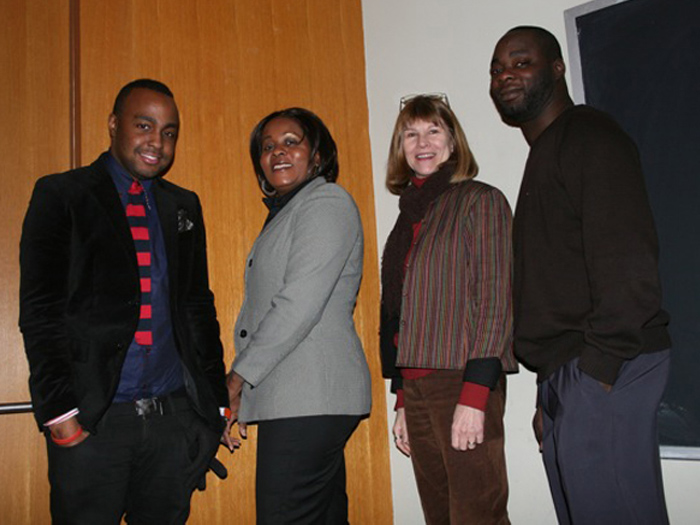High school students across Staten Island are building exciting engineering projects involving robots and engineering microcontrollers with a College of Staten Island engineering professor, thanks to a dynamic new summer workshop program as part of the Liberty Partnerships program sponsored by National Grid.
What:
A media event where CSI faculty and local high school students demonstrate the learning and problem solving skills involved with robotic construction.
Who:
Robert Huber, VP for Advancement, Exec. Dir. CSI Foundation
April Dubison, Community Relations Manager, National Grid
Neo Antoniades, engineering professor, CSI
Twenty students from four Staten Island High Schools: Curtis, New Dorp, Port Richmond, and Susan Wagner
Where:
College of Staten Island, 2800 Victory Blvd., Staten Island, NY 10314
Building 4N Microprocessor Lab, Room 105
When:
Thursday, July 24, 10:00am until noon
“National Grid supports initiatives that inspire and motivate students to pursue careers in math, science, and engineering — core skills that play a key role in our business,” said April Dubison, National Grid community relations manager. “We are happy to work with Liberty Partnerships program to help foster an interest in young people to be science and technology leaders of the future.”
“It is widely known in education that if students learn fun ways to approach problem solving then they will be more inclined to consider careers in science, technology, and more specifically engineering,” said Robert Huber, interim vice president for advancement at CSI.
The 20 students participating in the series of workshops with Dr. Neo Antoniades, associate professor of engineering science and physics at CSI, couldn’t agree more.
During the four-week program, the students form into engineering teams, divide the tasks, and follow the guidance of their project leader.
The exercises involve building experiments using the Lego Mindstorms set of building blocks that will allow the students to build several robot structures as well as a simple engineering microcontroller that will allow the students to learn some basic wiring and building of simple microelectronic circuits.
“The main goal of these two engineering project-building exercises is to teach students the basic concepts of engineering design,” said Antoniades. “Engineering design, like scientific methodology, is a way of thinking and approaching everyday problems in the world of engineering. This starts by teaching the students how to understand the problem, doing the appropriate research, and brainstorming before actually putting the ideas together and synthesizing the problem.”
# # #
BACKGROUND
The National Grid Engineering Workshop Series
The Liberty Partnerships Program (LPP) is a collaborative college-school-community-based project that provides a broad range of instructional, enrichment, and support services to at-risk students and their families. The main purpose of the program is to increase the motivation and ability of the students to go onto post-secondary education and/or meaningful employment.
This comprehensive program, which has served the needs of at-risk students since 1989, assists students in grades 9 through 12 and serves more than 200 students annually at four schools: Curtis High School,New Dorp High School, Port Richmond High School, and Susan Wagner High School.
Liberty Partnerships offers students in-school tutoring, counseling with college interns and mentors, as well as opportunities to take college campus tours, and attend Broadway shows and statewide conferences.
The program gives students a safe place to explore and discover their talents and interests. Students and staff are encouraged to try new experiences with support of our partners. LPP students produce outstanding contributions, serving in the military, attending colleges and universities, and working as entrepreneurs, professionals, and community activists.
Since 1990 Statewide Liberty Partnerships had 17,992 students graduated from high school through the Liberty Partnerships Program–14,841 entered postsecondary education and 2,684 entered the workforce immediately following high school graduation. Since 1997, the dropout rate among LPP students had been under two percent while the state dropout rate continues to grow. Annually the StatewideLiberty Partnerships Program sends 1,500 students to college.
Project Description
Liberty Partnerships looks to provide a series of workshops run by Associate Professor of Engineering Science and Physics at the College of Staten Island, Dr. Neo Antoniades.
The series of four, two-hour Saturday workshops aims to expose LPP students to exciting fields in the STEM disciplines. About 75% of the students from this program who go on to college come to CSI. The essence of Liberty Partnerships is to inspire these at-risk youth to stay in school, find rewarding careers, and contribute to the community. By exposing them to possible careers in a highly advance field it is hoped that this will engage them and motivate them in a particular direction.
There will be approximately 20 students participating. The proposed series of workshops will deal with a variety of topics that investigate careers and engineering:
-An introduction to engineering
-The trades of an engineer
-Fields of engineering (electrical, mechanical, computer, environmental)
-Engineering design
-The role of math in engineering and how math can be made fun
-The STEAM experience (Science Technology Engineering through Applied Math): The million dollar initiative at the College of Staten Island and how it can benefit the entering freshman engineer students at CSI (scholarship/mentoring)
-Research in electrical engineering: Focus is on the high-tech fiber optic industry
-How do you do research and why?
-The use of computer simulation as a powerful design and engineering tool — Live presentations with interactive participation
-Fiber optic networks in the USA
-The role of electronics in our lives
-Introduction to Microcontrollers — where are they used and why – real-life applications
-Hands-on experimentation using the PIC 18F microcontroller in a lab environment
About Dr. Antoniades
Neo Antoniades is an electrical engineer by training. He has been teaching engineering courses in the department with a strong focus in mentoring undergraduate students toward the science fields and graduate work. His primary research area is optical communication systems and networks. During his prior industrial career with Bell Communications Research and Corning Inc., Dr. Antoniades’s research activities included design, engineering, and prototyping support of next-generation Wavelength Division Multiplexing (WDM) optical systems and networks, modeling of transmission impairments, and research on new computer modeling techniques. His current research focuses on two areas: fiber optic communication systems and networks in the metropolitan area, and resilient telecommunication networking infrastructures. Prof. Antoniades is a member of various professional societies and technical committees in the communications field and holds two U.S. patents with three others pending. He is the author or co-author of over 50 publications in leading peer-reviewed journals and conferences.


![[gallery] CSI Honors Students Take Center Stage](https://csitoday.com/wp-content/themes/Extra/images/post-format-thumb-text.svg)












